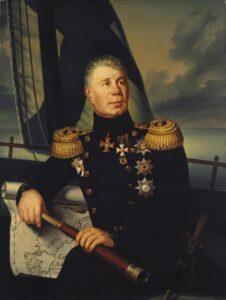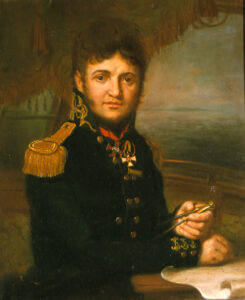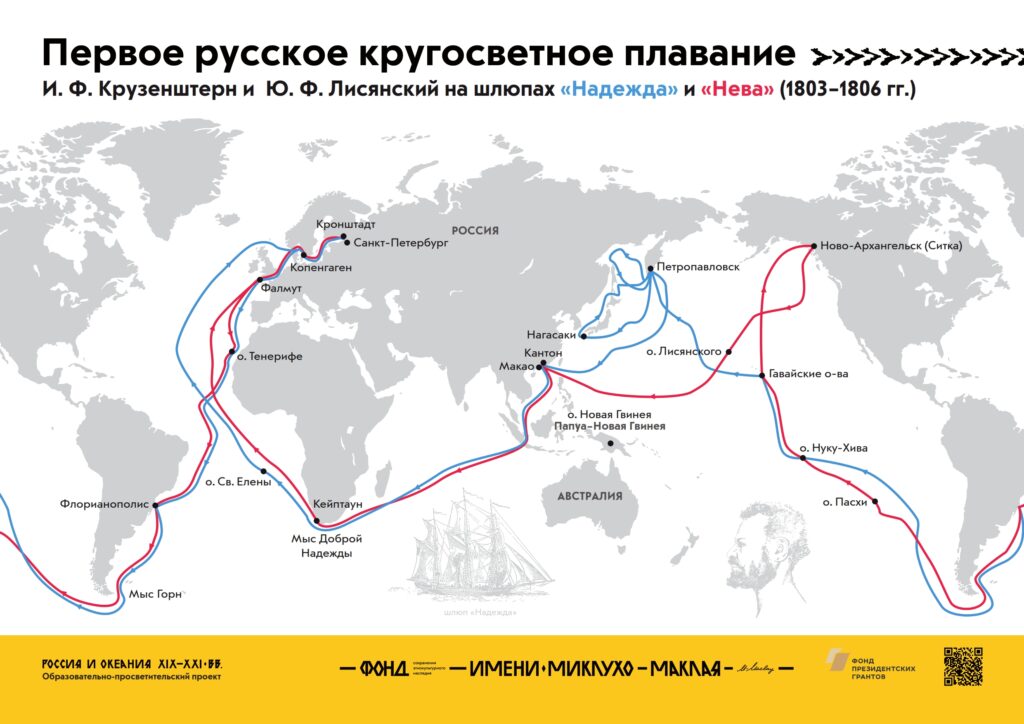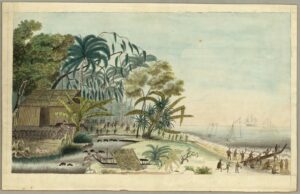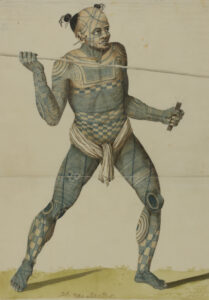First Russian circumnavigation by Adam Johann von Krusenstern and Yuri Fedorovych Lisiansky (1803–1806)
This voyage marked the departure of the Russian fleet to the open ocean and marked the beginning of Russian scientific research and discoveries in the world ocean. The purpose of the expedition was to link Russian America with the Baltic ports by sea. In Polynesia, Russian navigators visited the Easter Islands, Nuku Hiva (in the northern Marquesas Islands) and Hawaii, where they gathered valuable ethnographic information about the indigenous inhabitants. The oceanographic work carried out in the Pacific was of great importance.
At the turn of the XVIII and XIX centuries, the leading Western powers, primarily England and France, began to actively explore the South Pacific, competing for spheres of influence not only on land but also at sea. These states, for the first time in history, organized around-the-world expeditions with purely scientific purposes. For geographic, hydrographic, climatic, and other purposes, France set off an expedition to the Pacific Islands led by Louis Antoine de Bougainville, who was the first Frenchman to circumnavigate in 1766-1769, and two years later James Cook sailed from England, who had made three around-the-world expeditions between 1768 and 1779. These two captains discovered, explored, and mapped most of the islands of Oceania.
In the early XIX century, Russia organized the first scientific around-the-world expedition (1803-1806) under the command of two captains, Adam Johann von Krusenstern on the ship "Nadezhda" and Yuri Fedorovych Lisiansky on the ship "Neva", with the goal of creating a sea trade route between Russian America, the Russian Empire's possessions in Alaska, the Aleutian Islands, the Pacific coast of North America, etc., and Canton (now Guangzhou, the third most important city in China after Shanghai and Beijing) for the purpose of selling a valuable commodity, the fur of sea otters. The skins, which were in great demand in China, were taken in Russian America and transported to the country by land from Okhotsk (now a settlement in Khabarovsk Krai) through the town of Kyakhta (now a district center in the Republic of Buryatia), bordering China. The overland route could sometimes take two years, while the sea route would reduce the delivery time to 4 months, which would be very profitable for the Russian treasury.
However, the intended trade goals were not achieved due to the high competition with European and American traders, who had already occupied the niche of North American fur sales in China.
Also, unsuccessful was the attempt to establish political relations with Japan: Russia's first official Ambassador to Japan, Nikolay Petrovich Rezanov, was sent on the ship "Nadezhda", but because of the policy of strict isolationism that Japan pursued in those years, his mission was unsuccessful.
The first Russian circumnavigation team included the expedition chief and captain of the sloop "Nadezhda" A. J. von Krusenstern; captain of the sloop "Neva" Y. F. Lisiansky; senior lieutenant (future admiral) M. I. Ratmanov; midshipman Fabian Gottlieb von Bellingshausen, who in 1820 would discover Antarctica; the future leader of two circumnavigations (1815-1818 and 1823-1826) Otto von Kotzebue (Krusenstern's nephew), physician Karl Espenberg, astronomer Johann Caspar Horner, naturalists Wilhelm Gottlieb Tilesius von Tilenau and Georg von Langsdorff.
The ships "Neva" and "Nadezhda" followed the route Kronstadt - England - the Canary Islands - Brazil (St. Catherine Island), thence through Cape Horn in South America to Oceania. Then the ships separated: Krusenstern's "Nadezhda" sailed to Washington islands (now the Marquesas Islands) to Nukahiva island (now Nuku Hiva in the Marquesas Islands, part of French Polynesia belonging to France), and Lisiansky's "Neva" - to Easter Island. The ships met again near Nukagiva Island and sailed on to the Sandwich Islands (now Hawaii). Then "Nadezhda" departed for Kamchatka and thence to Japan, where it stayed for half a year, while the Ambassador N. N. Rezanov's mission lasted, while "Neva" headed for Kodiak Island on the southern coast of Alaska, where it stayed for 14 months, waiting for "Nadezhda". Meeting again, the ships sailed for Macao and Canton, where the attempt to sell the skins of sea otters, foxes, bears, and walrus bone from Alaska was difficult and only partially successful. Moreover, the Chinese Emperor was unwilling to break the overland trade through Kyahta and make trade with Russia by sea, so the plan to establish maritime trade between Russian America and Canton proved unrealizable. Then the ships sailed through the Cape of Good Hope to St. Helena Island and finally returned to Saint-Petersburg in August 1806.
The ethnographic material collected by the participants of the first Russian around-the-world expedition to Oceania is very interesting. In the South Pacific, in order to replenish fresh water and food supplies, "Nadezhda" and "Neva" had to pass through Easter Island and then through Nuku Hiva Island in the northern Marquesas Islands.
During the passage to the Pacific Ocean through Cape Horn in March 1804, the ships lost sight of each other because of a storm. Foreseeing such a situation, the captains agreed to meet at Nuku Hiva Island. Lisiansky successfully reached Easter Island, where he discovered large Moai statues, which are now the main attraction of the Island. When meeting the islanders Russian sailors addressed them with the word "teeo" ("friend"), which immediately attracted the locals to the strangers, and the communication between the representatives of the two civilizations was successful. Both sides treated each other very warmly, they exchanged household items, and knives were in demand among the islanders. After water and food supplies were replenished, Lisyansky sailed "Neva" to Nuku Hiva, where Krusenstern was awaiting, who lost time because of bad weather and therefore decided not to go to Easter Island in order to get the Russian Ambassador to Japan as quickly as possible, because Ambassador Rezanov insisted on it.
Of ethnographic value are Lisiansky's calculations of the Easter Island population, which he estimated at 1,500. It is known that 70 years later, by 1877, the number of the inhabitants reduced to 111, and in the 2010s the native islanders made up less than half of the approximately 6,000 total population of the Island.
When "Neva" reunited with "Nadezhda" at Nuku Hiva, it turned out that on board of "Nadezhda" there was daily trade with the islanders: food was exchanged for iron items, and the local "king" would come there more than once - he liked the mirror the most on the ship: he could stare into it for hours.
In order to regulate the time, which the islanders can spend on board, the captains periodically announced "taboos" - a ban on visiting the ship during certain hours. Taboo is a pervasive tradition of ritual prohibitions in Oceania, which was strictly observed and carried severe punishment for its violation, up to and including death.
Both Krusenstern and Lisiansky spoke very warmly of the locals, describing their appearance, emotions, manners, way of life and culture. In particular, the Russian sailors admired the art of tattooing, in which the inhabitants of the Marquesas Islands had no equal in Oceania. Almost all the expedition members made tattoos, including Krusenstern, who forever imprinted the name of his wife on his arm in French - "Julie" (Julia).
A "bridge" to mutual understanding was the two Europeans who had already lived on Nuku Hiva for about seven years, the Englishman Edward Roberts and the Frenchman Jean Baptiste Cabri, who hated each other as if showing on a person scale the enmity between England and France. Both were married to female relatives of local chiefs and led the same lifestyle as the locals.
An extraordinary story happened to the Frenchman Jean Baptiste Cabri: while saying goodbye to the Russian sailors in the evening aboard "Nadezhda", he got pretty drunk and fell asleep, and when he woke up and realized that he was still on board, "Nadezhda" was already far from the coast of Nuku Hiva. He claimed that Krusenstern had "stolen" him - a tattooed Frenchman from head to toe - as a local artifact, although the captain himself certainly denied it. Having arrived with the expedition team on Kamchatka, the Frenchman returned home to France by land through Siberia and Saint-Petersburg.
From the Marquesas Islands the ships "Nadezhda" and "Neva" sailed to Hawaii (then the Sandwich Islands) and arrived there in June 1804. Having replenished their provisions, Krusenstern departed for Kamchatka just two days later, while Lisiansky delayed for a week, since there was not yet enough provision for the long voyage to the Aleutian Islands.
Lisiansky visited the murder site of English captain James Cook, who had discovered Hawaii in 1778 and died in a skirmish with the islanders in 1779.
After collecting enough pigs from Hawaii, the most needed source of protein for the crew, in exchange for cloth and sailcloth, Lisiansky decided not to sail to the island of Oahu, where the local Hawaiian King's fleet was based, because of an outbreak of venereal disease, and "Neva" set sail from Hawaii, heading for the Aleutian Islands.
The expedition of Krusenstern and Lisiansky made an invaluable contribution to the development of science - cartography, hydrography, climatology, geography, oceanography, botany, etc., as well as ethnography: the expedition members made unique descriptions of the peoples of Oceania, collected culture and household items, which are now stored in the Kunstkamera (Peter the Great Museum of Anthropology and Ethnography) in Saint-Petersburg.
During the expedition, the members corrected errors in earlier maps; discovered inter-passage countercurrents in the Atlantic and Pacific Oceans; refined the coastlines of North America and Japan; and added the latitude and longitude of many geographic locations. Water temperature, salinity, currents, and tidal ranges in different parts of the oceans have been studied, which later formed the basis of oceanography, while weather observations subsequently contributed to the formation of climatology in the region. The cause of sea glow, which appeared to be caused by tiny organisms, was also elucidated. During the voyage, Chukchi and Ainu dictionaries were compiled. Russian Ambassador to Japan N. Rezanov created the first Russian-Japanese dictionary of 5,000 words. Words and notes of the musical composition "Ogre's Song" on the island of Nuku Hiva were recorded, which shows that cannibalism was, even if in the past, a part of the cultural tradition of the inhabitants of Oceania. The works of Krusensern and Lisiansky, published after the expedition, were soon translated into all major Western European languages. Later, in 1823-1826, Krusenstern published the most accurate at that time "Atlas of the South Sea" on the basis of maps drawn by himself, as well as his predecessors - J. Cook, Jean-François de Galaup, comte de Lapérouse, L. A. de Bougainville, and his successors - Otto von Kotzebue, V. M. Golovnin, and others.
Литература
Крузенштерн И. Ф. Путешествие вокруг света в 1803, 4, 5 и 1806 гг. на кораблях «Надежда» и «Нева»: По повелению е. и. в. Александра Первого. Под начальством флота кап.-лейт., ныне кап. 2-го ранга, Крузенштерна, Гос. адмиралтейского деп. и Имп. акад. наук члена. СПб.: Морская типография, 1809–1812. Ч. 1–3. http://shpl.dlibrary.org/ru/nodes/4877-kruzenshtern-i-f-puteshestvie-vokrug-sveta-v-1803-4-5-i-1806-gg-na-korablyah-nadezhda-i-neva-spb-1809-1812
Лисянский Ю. Ф. Путешествие вокруг света на корабле «Нева» в 1803–1806 годах. М., 1947. http://az.lib.ru/l/lisjanskij_j_f/text_0030.shtml
Федорова И. К. Восточная Полинезия: Эволюция татуировки // Электронная библиотека Музея антропологии и этнографии им. Петра Великого (Кунсткамера) РАН. 2006. С. 193. https://docplayer.ru/39565870-Vostochnaya-polineziya-evolyuciya-tatuirovki.html

